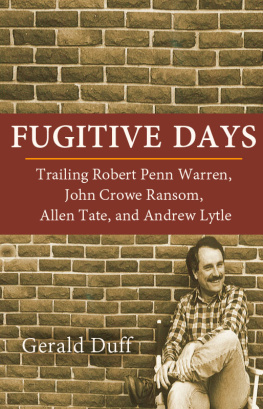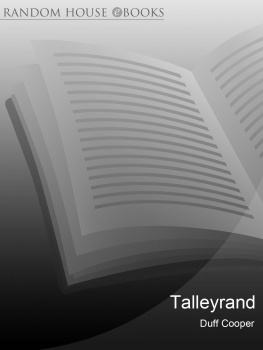This edition is published by ESCHENBURG PRESSwww.pp-publishing.com
To join our mailing list for new titles or for issues with our books eschenburgpress@gmail.com
Or on Facebook
Text originally published in 1935 under the same title.
Eschenburg Press 2017, all rights reserved. No part of this publication may be reproduced, stored in a retrieval system or transmitted by any means, electrical, mechanical or otherwise without the written permission of the copyright holder.
Publishers Note
Although in most cases we have retained the Authors original spelling and grammar to authentically reproduce the work of the Author and the original intent of such material, some additional notes and clarifications have been added for the modern readers benefit.
We have also made every effort to include all maps and illustrations of the original edition the limitations of formatting do not allow of including larger maps, we will upload as many of these maps as possible.
HAIG:
THE SECOND VOLUME
BY
DUFF COOPER
TABLE OF CONTENTS
Contents
TABLE OF CONTENTS
ILLUSTRATIONS
HAIG OF BEMERSYDE
LLOYD GEORGE, HAIG, JOFFRE AND ALBERT THOMAS, AT THE XIV CORPS H.Q., AUTUMN 1916
SIR WILLIAM ORPENS PORTRAIT OF HAIG, PAINTED AT G.H.Q., IN MAY 1917
HAIG IN HIS HEADQUARTERS TRAIN
HAIG IN THE FIELD
FACSIMILE OF HAIGS SPECIAL ORDER OF THE DAY, IN HIS OWN HANDWRITING, 12 APRIL 1918
HAIG AND BALFOUR AT VERSAILLES, 2 JULY 1918
HAIG, FOCH, PTAIN AND PERSHING
HAIG CONGRATULATING CANADIAN TROOPS AFTER THE BATTLE OF AMIENS, AUGUST 1918
QUEEN ALEXANDRA, WITH LADY HAIG AND HER TWO DAUGHTERS, STOPPING HAIGS CARRIAGE, 19 DECEMBER 1918
HAIG IN THE PEACE PROCESSION, 19 JULY 1919
HAIG FACING THE CAMERAS BEFORE LANDING AT VICTORIA, B.C., 13 JULY 1925
MAPS
1. OFFENSIVE AGREED UPON BY JOFFRE AND HAIG FOR 1917
2. THE NIVELLE OFFENSIVE
3. BATTLE OF MESSINES-WYTSCHAETE RIDGE, JUNE 1917
4. BATTLE OF PASSCHENDAELE, AUGUST-NOVEMBER 1917
5. PASSCHENDAELE, AUGUST-NOVEMBER 1917
6. CAMBRAI, 20 NOVEMBER-1 DECEMBER 1917
7. GERMAN OFFENSIVE, MARCH 1918
8. OPENING OF THE FINAL BRITISH OFFENSIVE, 8 AUGUST-9 SEPTEMBER 1918
9. THE AMERICAN ATTACK, 12 SEPTEMBER 1918
10. GENERAL BATTLE SITUATION ON THE WESTERN FRONT, 25 SEPTEMBER 1918
ADDENDUM
Page 193. Haig discovered soon afterwards that the first information which he received and recorded in his diary concerning the German counterattack of November 30 th 1917 was incorrect, but he made no further written reference to the event.
Chapter XVINEW LEADERS
The Duke of Wellington used to say that the chief problem of war was to find out what was taking place on the other side of the hill. Although the conquest of the air has taken from the aphorism some of its literal significance, it remains, in a more abstract sense, as true as when it was uttered. The Air Force can bring information with regard to the disposition of troops on the other side of the line, and some rough estimate may be formed of the number of casualties inflicted; but the more valuable information is not so easily obtained. The important things to know after a great battle are the psychological effect it has had upon the enemy, how hard it has hit him, how much it has hurt, what is taking place, not on the other side of the hill, but in the minds of the men in the trenches, at the headquarters of the generals and in the council chamber of the Government.
Difference of opinion as to the real result of the Battle of the Somme was to prove the main source of long and arduous conflict between men who should have been collaborating in complete harmony through the difficult days that lay ahead. There were some to whom it seemed that nothing had been gained but a few square miles of devastated territory, marked by the names of what had once been villages of slight importance. And this pitiful gain had been acquired at the price of tremendous sacrifice. If these premises were correct, the conclusion naturally followed that the war was being fought upon the wrong lines and that another method must be adopted.
Others, on the contrary, believed that the German Army had, with heroism, sustained a staggering blow; that the giant was tottering, and that if it were only possible to strike once more with equal force before his balance was recovered, he might come crashing to the ground.
That the latter view was the correct one is now generally admitted by unprejudiced historians of the war. Three facts may be recorded in support of it. After the Somme the Germans changed their Commander-in-Chief, just as they had changed him after the Marne; they deliberately prepared to withdraw from the line that they were holding and thus to narrow their front; and for the first time in the war they offered terms of peace to the enemy. It is possible that they may have found a better Commander-in-Chief; it is true that they strengthened their position by retiring; and the peace terms that they offered were certainly not those of a beaten nation. But even the German authorities limited knowledge of psychology must have warned them that the three events taken in conjunction were bound to strike a chill into the hearts of a population that had been fed on tales of an all wise High Command leading an overpowering, invincible army steadily forward to complete victory and the dictation of terms to an utterly vanquished foe.
Haig and Joffre were not yet in possession of all the facts, and they were long to remain in ignorance of the evidence from enemy sources quoted at the end of the last chapter, but their soldierly instinct told them that they had struck hard and true, and that it was their duty to press home their attack.
Before the battle was over they were already taking counsel with one another as to their plans for the coming year. On the 1 st of November Joffre wrote Haig a long letter in which he outlined his proposals. The following were his main points. The French and the English attacks should be delivered simultaneously, and the front over which they were delivered should be as broad as possible. The limits of the English attack were to be, roughly, Bapaume and Vimy, while the French advanced through the valleys of the Oise and the Somme. This would leave an extensive gap between the two attacking armies. Here the Allies should act on the defensive, assuming that, if the two attacks succeeded, the enemy would be compelled to retire in order to preserve his centre from becoming isolated. Meanwhile, during the winter months, a continual offensive on a minor scale was to be maintained. The enemy was to be given no peace. Harassed as he already was, he was not to be allowed a moments breathing space wherein to collect his thoughts and to calm his nerves.
Haigs reply to Joffres letter is printed in full in the appendix. It is important because it has been asserted {1} that Haig was unwilling at the time to collaborate in Joffres plan, and that it was due to the condition of the British Army that the successes of the Battle of the Somme were not followed up. The text of his letter proves, on the other hand, that he entirely concurred in Joffres views, that he was prepared to do everything in his power to assist in carrying them out, but that he thought it wise to warn Joffre beforehand of the difficulties under which he was fighting and of the limitations that those difficulties must impose upon the success of his efforts.














